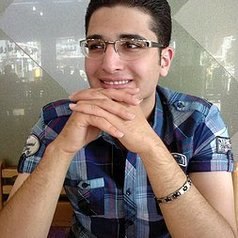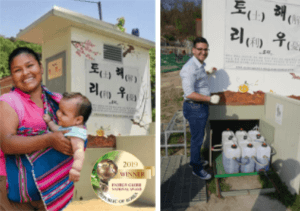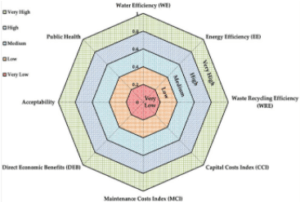This year Cactus Communications celebrates 20 years of supporting researchers on their publication journeys. Starting with our editing service, Editage, CACTUS soon expanded to publication support, pre-submission checks, research impact creation, and other solutions for researchers’, needs beyond publication. To celebrate, we recognize researchers from across the globe who share our vision in supporting and empowering researchers in this interview series.
Please briefly introduce yourself, focusing on your research experience and achievements.

My name is Shervin Hashemi, and my heart beats for our planet I am a senior researcher working with the Institute of Environmental Research, at Yonsei University College of Medicine. I work on a concept related to water and sanitation that I developed throughout my career during my academic studies and post-doctoral work. I focused on a strong desire to develop a nature-based solution for the global water and sanitation crisis that also overcame technical, economic, and social obstacles. I wish to see the day when anyone on our planet, regardless of gender or age, has safe and adequate access to clean water and sustainable sanitation.
Your research expertise is on providing water and sanitation in remote areas. These research directions all require fieldwork. For such topics that require fieldwork, please share with us some unique research methods.
It is very important to understand the problem first. Having a good vision of the goal of a study may be one of the keys to starting research. Accessing safe water and sanitation in remote and rural areas requires solving several challenges. Some areas do not have sufficient water infrastructures and facilities. In some areas, water is so little and precious that can only be used for drinking. At that time, I was aware that Urine-Diverting Dry Toilets (UDDTs) were under development to provide waterless sanitation services. However, such services had other challenges, such as odor, fecal exposures, etc. So I tried to see if I can use science to at least control such shortcomings. I started to see what other researchers do and how I can improve their works and make a new direction. For my research, the fieldwork was almost the final stage of developing the system. Beforehand, I tried several methods in laboratory scales to see if they can work well or not. It is important to argue with numbers and scientific logic. Since the results were satisfactory, I could convince the authorities to let me test the system in the field.
Your Resource Circulated Sanitation system won the Leaving No One Behind Innovation Award 2019 and Energy Globe Republic of Korea National Award 2019. Please briefly describe the system and how did you get this inspiration. What do you think is the relationship between research results and awards?

To solve global sanitation challenges, most approaches aim at a one-size-fits-all solution, which neglects important social and cultural aspects such as acceptability and affordability of the solution in the community where it is going to be implemented. The Resource Circulated Sanitation system was first developed in South Korea and designed for utilization in remote and rural areas. It became a good model of a sustainable, resource-oriented sanitation technology that treats sanitary waste as a valuable resource that can be economically beneficial to the community in the form of fertilizer. In this approach, traditional Korean toilet culture and attitudes toward separating waste at the source and reusing waste were considered. Using treated sanitary matter as fertilizer and soil conditioner demonstrated both environmental and economic benefits. To boost social acceptance and a sense of ownership and responsibility towards the new system in the community, continuous provision of maintenance services and training were provided.
I believe that those awards are given to this project since the developed system was aimed to be a nature-based solution for providing safe and adequate sanitation for all, leaving no one behind. Results in both field and laboratory could support the sustainability of the system to be a step forward for achieving the 6th Sustainable Development Goal (SDG6). For more information, you can refer to my post prepared for the International Water Association (IWA) official blog.
You developed the Sanitation Sustainability Index to evaluate the technical, economic, and social sustainability of the local sanitation systems. How did this index come about? How influential is it now?
Sometimes sanitation systems are developed with an outstanding scientific background and use high-tech to serve as a solution and approach toward achieving SDG6. However, there is still a risk of failure for such systems when being implemented, if they are not properly evaluated with robust and reasonable indicators before implementation. Therefore, technical, economic, and social issues usually emerge after implementation and can lead to a project failing. The Sanitation Sustainability Index is designed to serve as a community-based indicator to evaluate different sanitation options for a specific community based on the technical, economic, and social characteristics of the sanitation system before implementation. It has several sub-indices to evaluate if a sanitation system can be sustainable for implementation in a community or not.
 The index is flexible and can be used to evaluate any sanitation system for implementation in any community. It is community-based which means that one sanitation system can be evaluated as low sustainable for a certain community while the same system can get a high sustainability score in another community.
The index is flexible and can be used to evaluate any sanitation system for implementation in any community. It is community-based which means that one sanitation system can be evaluated as low sustainable for a certain community while the same system can get a high sustainability score in another community.
The idea is published as a paper in the journal of Sustainability (ISSN 2071-1050) in September 2020 as an open access article. According to Google Scholar, the paper has been cited around 20 times within only 2 years. I am happy that scientists around the world are showing interest in this idea. Sometimes I receive contacts from scholars having an idea to improve the index, so it seems to be influential so far. Of course, I am still working on improving it.
You are a member of the management committee of the IWA Resource-Oriented Sanitation Specialist Group. What’s your job basically about at IWA?
As a member of the management committee of the IWA Resource-Oriented Sanitation Specialist Group, I try to spread the idea of utilizing resource-oriented sanitation systems through conducting conferences, webinars, workshops, and other educational programs. We focus on middle and low-income countries that are suffering from a lack of access to sustainable water and sanitation.
At IWA, you must have come into contact with many outstanding people who have contributed to the earth. Which one or several ones have touched you the most? Please tell us about their stories.
IWA is a huge organization and includes people who are working on different aspects of water management. It is very difficult to bold one person or two to say that they have touched me. They are all outstanding scholars and I am still learning from them. We all have the same story and dream to see everyone around the world happy without concerns about to access clean water and sanitation.
How many papers have you published so far, which one is the most impressive one? Please recall the history of its publication.
Since 2015, I have published 22 papers. They all have interesting research and publication stories. The one entitled “Sanitation sustainability index: A pilot approach to develop a community-based indicator for evaluating sustainability of sanitation systems” may be the most impressive one considering that it has the highest number of citations so far. It had a challenging history of review and publication. The reviewers were raising interesting comments that could improve the index to be more practical and realistic.
You are associated with the journal Sustainability (ISSN 2071-1050) as a member of the editorial board. During your review process, what qualities do you value most in a manuscript?
The first thing I check is the abstract. The abstract, if written well, can reflect the whole paper. Through checking the abstract, I try to figure out if the topic of the work is related to the journal or not. If yes, if it is an ordinary one or one of the global priorities. Also, I try to check the literature trend to see if the submission is novel and has the potential to attract citations or not. For this, I usually read the literature review part of the introduction and the expression of the research objectives. In the next stage, I check the methods carefully. Finally, the whole work will be checked for plagiarism detection.
Please give some advice to masters and doctoral students who are just starting to write their thesis?
Masters and doctoral students are all outstanding and respectful. Because at their age they naturally may need to have fun and enjoy life, but for any reason, they have decided to spend the best time of their life studying and discussing with their advisors. I wish to advise them to be patient. No pain, no gain: great things always come with effort. I wish you always keep your confidence high. Small or big, if your research is genially yours and not a copy from someone else, it will find its place. You worked so hard to conduct your research and now it is time to report it as your thesis. Try to highlight the value of your work and let it shine. In that case, you will be proud of your work, which can be also helpful to others.
What is your dream regarding to your research life? Where do you see yourself in 20 years?
My dream is to see my works are practically influential and can help people to live easier and healthier. In 20 years, I wish to be able to help and advise several outstanding and practical researchers to persuade their dreams of making this world a better place to live.
A version of this interview was first published on the Editage China WeChat account. Advance your research journey through the Researcher.Life Ambassador Program – apply today!


